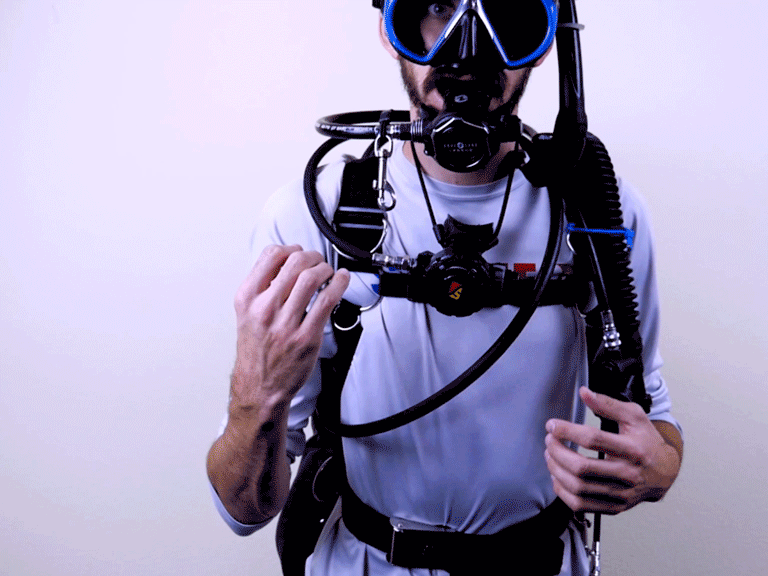I am new to diving with a BP&W. I purchased a Halcyon Infinity BP&W. I cannot really find a good place to put the octopus. Anyone have suggestions? . . . Where does everyone keep there's at?
As you can tell, there are several schools of thought, and the answer(s) may well depend on the breadth of experience of the diver, and their particular priorities in equipment configuration. There is no ONE AND ONLY ONE correct answer.
In the context of your specific question - diving a BP/W, where should you place your alternate air source -
the most common answer is, on a bungee necklace. To understand the reasons for the answer, it is probably useful to consider the response in a broad context.
A diver's move to a BP/W often represents more than a mere choice of a BCD. It is part of developing a personal philosophy of diving, which include optimization of the diver's overall gear configuration. And, that optimization involves more than just what is viscerally convenient / comfortable for the diver. Going to a BP /W involves considerations that involve streamlining, that involve comfort, that involve modularity, that involve optimal weight distribution, etc., etc. A jacket BCD is safe and fully functional at a basic level. But, a BP/W configuration is also safe, and is fully functional at a basic level, and IN ADDITION, provides performance characteristics to the diver that are simply not found in most jacket BCDs.
The same diver who makes a decision to go to a BP/W also begins to consider the optimal regulator configuration. And, notwithstanding the fact that most OW students are initially trained to respond to an OOA situation in another diver by donation of an alternate air source, a growing community of divers have come to see donation of the primary air source, rather than the alternate, as superior in terms of safety and functionality. What is optimal in a 'primary donate' regulator configuration? 1) The selection of second stages that are equivalent in performance, so that BOTH the donor and recipient have a good supply of air, since both are likely to be stressed by the situation. The donor is giving up the comfortable, easy breathing primary regulator that they use for their diving. It is dysfunctional for them to go to an alternate second stage that is needlessly detuned, and of lower performance than what they just gave up; 2) placement of the donor's alternate air source such that it can be easily and IMMEDIATELY accessed by the donor after giving their primary to the OOA diver. A second stage placed on a bungee necklace is more immediately accessible to the donor that an alternate secured by one of the many (mostly useless) 'octo holders' - the donor knows exactly where it is at all times, and it can be accessed by a single hand motion (sometimes even without using a hand and simply lowering the head and grabbing it in the mouth); 3) use of hose lengths that facilitate both efficiency and convenience of donation, and provide a streamlined configuration. This is probably the 'softest' criteria, although it seems to generate (too) much of any discussion. The 'standard' regulator hose lengths - a 32 - 36" primary air source hose, and a 40" alternate air source hose, can be easily used in a 'primary donate' configuration. The diver simply uses the 40" hose for the primary second stage, and uses the shorter hose with a bungeed necklace alternate second stage. Now, doing this results in less than optimal streamlining, so divers who elect to go with a 'primary donate' option will usually adjust their hose lengths, to a longer primary hose (e.g. 60", or 84") and a shorter bungeed necklace alternate hose (e.g. 28-30"). But, the standard hose lengths cannot nonetheless be used.
Several references have been made to what divers may 'see' among other divers, and the frequency with which different configurations are 'seen'. Unfortunately, those observations may be used as an indicator of what is optimal, and that can be misleading. A BP/W is a BCD, it is not at all restricted to use in technical diving, and its growth in popularity among recreational divers has been obvious in recent years. I see more BP/Ws on recreational divers than I did a year ago, certainly many more than I did 5 years ago, and a whole lot more than I did a decade ago. I agree that I see more divers in jackets BCDs, or soft back-inflate BCDs, than I do in BP/W configurations. But, I am also seeing an evolution and changing numbers among certified divers. In addition, what a diver trains in has very little to do with what is
optimal for the train
ee, rather it reflects what is considered convenient, and cost-efficient for the train
er. I used to train students in rock-climbing. I wore a harness that was considered to be 'high end' (a euphemism for expensive), and it was sized to fit ME. While I could put another climber in it, the range of student sizes that could be accommodated by my harness was limited, and adjustments took time. So, I put my students in a simple, but safe and secure, web harness that could be quickly adjusted to fit a variety of climbers. It was also RELATIVELY INEXPENSIVE, and I could afford to have 4-5 available for students. During training, I repeatedly told train
ees that, if they wished to go on with climbing, beyond the basic course, they should get their own harness, I pointed out the advantages of what I was wearing, not as a brand / model but as a functional style.
Share This Page

